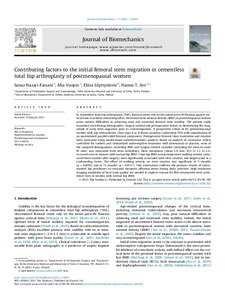Contributing factors to the initial femoral stem migration in cementless total hip arthroplasty of postmenopausal women
Nazari-Farsani Sanaz; Vuopio Mia; Löyttyniemi Eliisa; Aro Hannu T
https://urn.fi/URN:NBN:fi-fe2021042821923
Tiivistelmä
In cementless total hip arthroplasty (THA), femoral stems rely on the initial press-fit fixation against cortical bone to achieve osseointegration. Decreased bone mineral density (BMD) in postmenopausal women poses natural difficulties in achieving axial and rotational femoral stem stability. The present study examined contributing demographic, surgery-related and postoperative factors in determining the magnitude of early stem migration prior to osseointegration. A prospective cohort of 65 postmenopausal women with hip osteoarthritis (Dorr type A or B femur anatomy) underwent THA with implantation of an uncemented parallel-sided femoral component. Postoperative femoral stem translation and rotation were measured using model-based radiostereometric analysis. Based on analysis of covariance, which controlled for outliers and randomized antiresorptive treatment with denosumab or placebo, none of the analyzed demographics (including BMI) and surgery-related variables (including the stem-to-canal fil ratio) was associated with stem subsidence. Stem subsidence (mean 1.8 mm, 95% CI 1.2 to 2.4) occurred even in women with normal hip BMD. Total hip BMD and postoperative walking activity (measured three months after surgery) were significantly associated with stem rotation, and height acted as a confounding factor. The effect of walking activity on stem rotation was significant at 5 months (p = 0.0083) and at 11 months (p = 0.0117). This observation confirms the previous results of instrumented hip prostheses on torsional moments affecting stems during daily activities. High-resolution imaging modalities of local bone quality are needed to explore reasons for RSA-measurable stem subsidence even in women with normal hip BMD.
Kokoelmat
- Rinnakkaistallenteet [27094]
